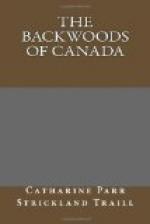We shall have about three acres ready for spring-crops, provided we get a good burning of that which is already chopped near the site of the house,—this will be sown with oats, pumpkins, Indian corn, and potatoes: the other ten acres will be ready for putting in a crop of wheat. So you see it will be a long time before we reap a harvest. We could not even get in spring-wheat early enough to come to perfection this year.
We shall try to get two cows in the spring, as they are little expense during the spring, summer, and autumn; and by the winter we shall have pumpkins and oat-straw for them.
LETTER IX.
Loss of a yoke of Oxen.—Construction of a Log-house.—Glaziers’ and Carpenters’ work.—Description of new Log-house.—Wild Fruits of the Country.—Walks on the Ice.—Situation of the House.—Lake, and surrounding Scenery.
Lake House
April 18, 1833
BUT it is time that I should give you some account of our log-house, into which we moved a few days before Christmas. Many unlooked-for delays having hindered its completion before that time, I began to think it would never be habitable.
The first misfortune that happened was the loss of a fine yoke of oxen that were purchased to draw in the house-logs, that is, the logs for raising the walls of the house. Not regarding the bush as pleasant as their former master’s cleared pastures, or perhaps foreseeing some hard work to come, early one morning they took into their heads to ford the lake at the head of the rapids, and march off, leaving no trace of their route excepting their footing at the water’s edge. After many days spent in vain search for them, the work was at a stand, and for one month they were gone, and we began to give up all expectation of hearing any news of them. At last we learned they were some twenty miles off, in a distant township, having made their way through bush and swamp, creek and lake, back to their former owner, with an instinct that supplied to them the want of roads and compass.
Oxen have been known to traverse a tract of wild country to a distance of thirty or forty miles going in a direct line for their former haunts by unknown paths, where memory could not avail them. In the dog we consider it is scent as well as memory that guides him to his far-off home;—but how is this conduct of the oxen to be accounted for? They returned home through the mazes of interminable forests, where man, with all his reason and knowledge, would have been bewildered and lost.




